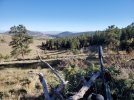Maybe I am not the experienced knife sharpener I fancy myself to be... but no matter how I sharpen a knife, I find that it loses its hair-shaving ability fairly quickly. I've had a selection of abrasive stones, commercial systems like the TriAngle Sharpmaker, diamond tools, abrasive paper and stropping compound. I've watched 'experts' on YouTube, and read reports on how many bits of wood can be chopped before an edge loses its ability to shave. I've purchased magnifiers so that I can take a good look at an edge.
I prefer a thin, 'sharper' angle on my blade, but I've also tried bigger angles that are naturally stronger and which might be less likely to deform. But they all get blunt relatively quickly when skinning and butchering game. When I started hunting, a lot of hunters and farmers had a large belt sheath which held both their knife and a short sharpening steel. I carried a steel for a while, but stopped eventually. However if there is a lot of meat or fish to be processed, I can't think of a better way to keep a knife in sharp working condition than the careful use of a good old-fashioned sharpening steel. I have carried small pocket stones and diamond sharpeners, but they don't really seem to work as well for me as a few strokes along a good steel. I worked in the fish processing industry for a few years, and while abrasive stones were regularly used to keep the right geometry on a knife, I observed that sharpening steels were in constant use.
While heavier (thicker) blades have their uses ( a BK9 with a thin blade would not be a good chopper, hammer or lever), I prefer a thinner blade of relatively 'soft' knife steel for fish and game processing. My reasoning is that the softer steel responds well to the sharpening steel, and the blade is less likely to snap or chip. A blunt or unsuitable knife can really detract from the joy of a good day out.
But I've learned something else too. When I was a young guy I was in the right religion and I really knew stuff. Now I realise that I was a bit of a tosser in that regard... and while I have had a lot of experience, a lot of it has shown me that I know very little.








